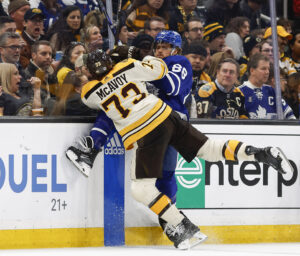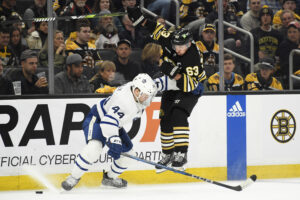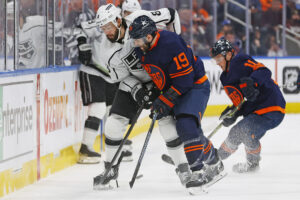The 2021 NHL Draft does not pose the same excitement as the 2020 NHL Draft did. However, there are still plenty of players that teams can build around for the future. There’s another future star goaltender in this class, falling in line with goalies like Spencer Knight and Yaroslav Askarov before him. There are several defenders in the 2021 NHL Draft class, though, as opposed to 2020 where there weren’t many defensive prospects. Finally, there are a plethora of forwards who have futures at the NHL level.
Click here to check out Part One, where the 11th to 15th overall picks of Kyle Pereira’s 2021 NHL Draft Rankings and some notable omissions are broken down!!
2021 NHL Draft: Kyle Pereira’s Top 10
1. Jesper Wallstedt, Goalie
Jesper Wallstedt is the third straight goalie heading into his draft year expected to be a franchise-altering talent. He’s also the fourth goalie in five years. In 2017, it was Jake Oettinger. For 2019, it was Spencer Knight. In 2020, it was Yaroslav Askarov. Now, in the 2021 NHL Draft, Wallstedt has his moment. The difference between the aforementioned guys and Wallstedt is athleticism and technical abilities. Athletically, Wallstedt does not compare to Knight or Askarov. Wallstedt cannot consistently make mind-blowing acrobatic saves, because he simply isn’t as fast or fluid in his pushes and side-to-side movements.
His technical ability trumps the previously selected goalies. He tracks the puck extremely well, seals the bottom of the net, and has superb positioning. His movements are robotic and with a purpose, relative to being fast. He’s also much better at controlling his rebounds than probably every first-round goalie taken in the last ten years. In a weak class, he could be the first taken in 2021.
2. Matthew Beniers, Center
This may be a stretch having Matthew Beniers at two. However, he is arguably the most well-rounded prospects in the class. His upside is certainly limited, based on his style and skill-set. However, he likely could step into the NHL directly following the draft. His awareness both with and without the puck is at a high level.
Playing in Michigan with Kent Johnson, who is great in the offensive zone, he does all the dirty work to make Johnson better. Beniers grinds in the defensive zone and provides immense value there as a center.
He also does a phenomenal job moving the puck up the ice in the transition, grading out as one of the best transitional players in this class. His offensive abilities are certainly limited, but his playmaking ability is underrated as it currently stands, and he’s a guy that, paired with a goal-scorer, could be a 50-60 assist producer at the NHL-level.
3. Fabian Lysell, Right Wing
Lysell may just be the best skater in the 2021 NHL Draft. His speed is lethal, his edges are smooth, and he possesses strong balance. His stride is technically sound. And he pairs that skating ability with high-end stickhandling and awareness. He times his dekes extremely well, and does not force plays for the sake of forcing plays.
He uses his smarts to pick out the right times to utilize his stickhandling abilities and, based on the defenders positioning, he uses the right move to get by him. Even when he decides not to dangle, Lysell is so good at using his speed to get by defenders, get low and lean against the defender and cut to the front of the net for a scoring chance.
Lysell’s Upside
His passing ability and vision, paired with the aforementioned awareness, makes him a high-end playmaker, as he can create space for himself with his individual skill, which buys time for his teammates to get open. His shot does need some work, but he still possesses a strong shooting ability making him a very unpredictable and difficult to defend forward.
As if it couldn’t get better, he possesses a strong ability to defend, using an active stick, high-end anticipation and excellent work ethic. His transitional game is lacking, but that’s more due to the fact he plays against men, with limited time, but he possesses the qualities needed to be a very good transitional player as he matures.
4. Carson Lambos, Left-Handed Defenseman
The first defenseman in a loaded 2021 NHL Draft defensive class, Lambos has been somewhat disappointing this season. Being loaned to Europe, he was expected to have growing pains, but he adjusted surprisingly well. Where the concerns come into play is in his decision-making. When pressured, he takes too long to act on a play, and other times, he makes the play too slowly. He has turned the puck over quite often.
But the important thing to note here is this: Lambos was loaned to Europe, playing in rinks that are bigger than the ones he grew up playing in, against players who have played in those said rinks for their entire lives. There’s also the language barrier and, at 18, being so far away from his family. His adjustment and quick call up to the U20 league, is a testament to just how talented Lambos is. Yes, he has struggled. Yes, based on what he has shown, there are some questions about his upside. But he is so mature that he has a projectable future as, at the least, a #4 defenseman in the NHL.
Lambos’s Offense and Upside
His offensive game is strong, as he possesses a great shot and very good passing ability. His IQ is through the roof, which also helped him translate his talents to Europe. Lambos’s offensive zone positioning is excellent, as he follows the play well and puts himself in positions to make an impact in the offensive end. His transitional abilities fall in among the best in the class as well, and his defensive game is strong.
Though he does turn the puck over at a rate higher than what most would like to see, he more often than not makes up for it by getting back in positioning and breaking up the opposing scoring chance. That said, he looks to be a future #1 or #2 puck-moving two-way defender with both powerplay and penalty kill upside.
5. William Eklund, Center/Left Wing
Eklund is similar to Lysell in a lot of ways. He is an excellent skater, though not as fast. He possesses more strength and aggression in his game as well. Just like Lysell, Eklund is reliable in the defensive zone, showing excellent anticipation, positioning and a high-level work ethic. However, they couldn’t be more different with how they attack the offensive end. Eklund is more of a goal-scorer. His shot is much better than that of Lysell, and his passing is not as threatening.
Eklund does not possess the stickhandling and creativity that Lysell has either, and he attacks the offensive zone with his off the puck abilities, and with how he exploits defensive zone coverages in order to get himself into a position to score. If it was not for an injury sustained earlier in the year, Eklund could be higher on the list, easily. Him and Lysell both look like guys who could be lethal offensive producers. However, they have a relatively low floor, which is why Beniers has the edge over both, at the moment.
6. Xavier Bourgault, Center
This might be the most surprising name so far. Beniers is rated highly by most. Lysell and Eklund are both lauded for their skill. But Bourgault? Hear me out. Bourgault plays with immense IQ and anticipation. The little nuances and detail-oriented plays he makes set him apart from so many of the other players not yet mentioned. He pairs that awareness with his skating ability.
Bourgault may not be at the level of the Swedes in this class, but he still grades out as a top-10 skater in the class. He has good speed and fluid edges, with excellent acceleration. He builds up his speed quickly through his crossovers and edges really well. Bourgault is also creative and possesses good stickhandling, though he doesn’t always flash it.
Bourgault’s Transition and Upside
His transitional ability might be the best in the class, as he is almost always in the middle of every break-out and zone entry for his team, and he is so effective in doing so. The reason is his high-level anticipation, which was previously mentioned, as well as his vision and passing ability. In the offensive zone, Bourgault does a nice job putting himself into position without the puck, and with the puck, is a two-way threat.
His shooting ability is better than his passing, but either way, defenses need to be wary when he has the puck on his stick. However, his upside does vary. For me, he looks like a future #2 center with powerplay upside, but there’s also an argument that he is more of a future #3 center. With his awareness, transitional abilities, skating, and work ethic, I’m a Bourgault Believer.
7. Brandt Clarke, Right-Handed Defenseman
Clarke, like Lambos, was also loaned to Europe. His transition has not been so kind. His offensive game is still king, as he acts as a fourth forward at times on the ice, and provides superb passing abilities, paired with a solid shot. He’s a good skater, with speed and power paired with fluidity in his edges, and his ability to walk the blueline and open up passing and shooting lanes brings a lot of value. However, his defensive abilities are a slight concern. His positioning isn’t always very good, and needs work. Playing in a men’s league has helped him piece together his defensive abilities, which is obviously a massive sign. His upside is sky-high.
Though the regression in his transitional abilities do bring about concerns, leading to him outside of my top-5, he still possesses all of his quality traits to return to the effective puck-mover he was in major juniors. Clarke still looks like he has a great future, but if he cannot round out his game, he has a low floor. Ultimately, he has the stylistic comparison to that of Erik Karlsson, but he is very raw in most of his game. He is a couple years out from being NHL ready.
8. Aatu Raty, Center
Raty is an interesting case. He went from being a phenom and highly touted 2021 NHL Draft prospect at the ages of 15 and 16, to seemingly showing very few signs of improvement from that point forward. Granted, his ability to adapt to his surroundings, in terms of adjusting to find success, at every league he has played in shows promise. Add to that, the fact that he has been playing at a high level since he was 15 shows he has to have a high-end hockey IQ. You have a guy who could quite easily make the NHL right out of the draft, depending on the team that selects him, and adapt quickly.
His awareness is top-tier, as mentioned earlier, with his ability to read the play quickly and constantly put himself in areas to be a threat. He is a solid transitional player in a league where it is tough to showcase that ability at his age. His passing is high-end, and his shooting abilities pose a threat when he lets a shot loose. The power behind his shot is very clearly there, but to be even more dangerous, his accuracy needs improvement.
Raty’s Skating and Upside
His defensive game needs work, and that’s why he likely ends up playing on the wing at the NHL level, but that could open up his offensive and transitional games further. The reason he isn’t on this list is his skating ability and questionable upside. He doesn’t possess great speed, though it is above average. His edges need considerable work, as he often takes wide turns and loses speed in doing so. And like I stated earlier, he very well could be in the NHL as soon as next season, but the lack of growth since making big strides at a very young age makes you question if he’ll peak early in his NHL career and never take the next big step.
As of now, Raty projects as a middle-six winger with the ability to play center if needed. He looks like a guy who could quickly establish himself as a 50-point scorer, but never truly exceed that mark. If he is able to take that next step, as well as be paired up with a two-way goal-scorer, he could total 50-60 assists in a season, and record at a point per game pace. However, the likeliest outcome, due mostly for his skating holding him back, is the initial projection I have for him.
9. Cole Sillinger, Center
Playing in the USHL this season due to the WHL yet to return, Sillinger does not look like the same player. He didn’t regress by any means, however, Sillinger seemingly never looks engaged at the USHL level, and that hurts his overall grade for me. I can only scout what I see, and because he isn’t pushing himself at the USHL level, he doesn’t look to be the same skater he was in the WHL. However, there are certain things that cannot be denied when it comes to Sillinger: his shooting, anticipation, and awareness. Sillinger has high-end instincts, both with and without the puck, and he has arguably the best shot in the class.
Sillinger’s Upside
Jack Quinn is where I would start with the comparisons, but Sillinger is a much better player when the puck isn’t on his stick. Quinn is the better skater and in my viewings, better in the defensive zone, but Sillinger exploits defensive zone coverages in a way Quinn didn’t. He’s constantly putting himself into positions to receive passes from teammates. But to put it simply, Sillinger needs the WHL to come back sooner rather than later, and when it does, he could sky-rocket up these rankings. His upside is tantalizing, his skating is better than he has shown, and when he is fully engaged, he can be a game-breaker. His upside is hard to gauge, however. He either projects as a future 30-40 goal-scorer at the NHL level, or a scoring third-line winger with powerplay time. Only time will tell.
10. Stanislav Svozil, Left-Handed Defenseman
Arguably my favorite prospect, next to Wallstedt and Beniers, Svozil is excellent. He grades out as a top-five player, when using my grading system, but what sets him down to 10th is his upside. Svozil is a shut-down defenseman. His engagement and awareness in the defensive zone, both positionally and situationally, is bar-none in this class. His transitional game is also solid, and grades out as a top-3 transitional player in this class, as of now. However, he does not do much offensively. He possesses otherworldly vision and creativity when it comes to passing the puck and moving up ice, but when in the offensive zone, he takes the back seat and watches.
Svozil’s Defense and Upside
He’s so aware of his defensive responsibilities that he is almost reluctant to jump up in the play and push for scoring chances. When the puck is on his stick, he finds the open man and gets it there. He’s safe, smart, and almost mistake-free offensively. But he does not control the pace and he does not push for scoring chances.
That holds back his upside, and might make him an overall less attractive prospect for most NHL teams. But if there is a team with needs on the left-side of their defense core, and they need to bolster their defensive zone coverage, there is no one better than Svozil in this class. New York Rangers, checkmate. Anyways, his upside checks out as a future #2 or #3 defenseman, playing alongside an offensive-leaning defenseman. His puck-moving abilities open the door for more upside, but until he shows a willingness to jump up, even just from time to time, in the offensive zone, he may never be considered a top-pairing player.
Main Photo:






